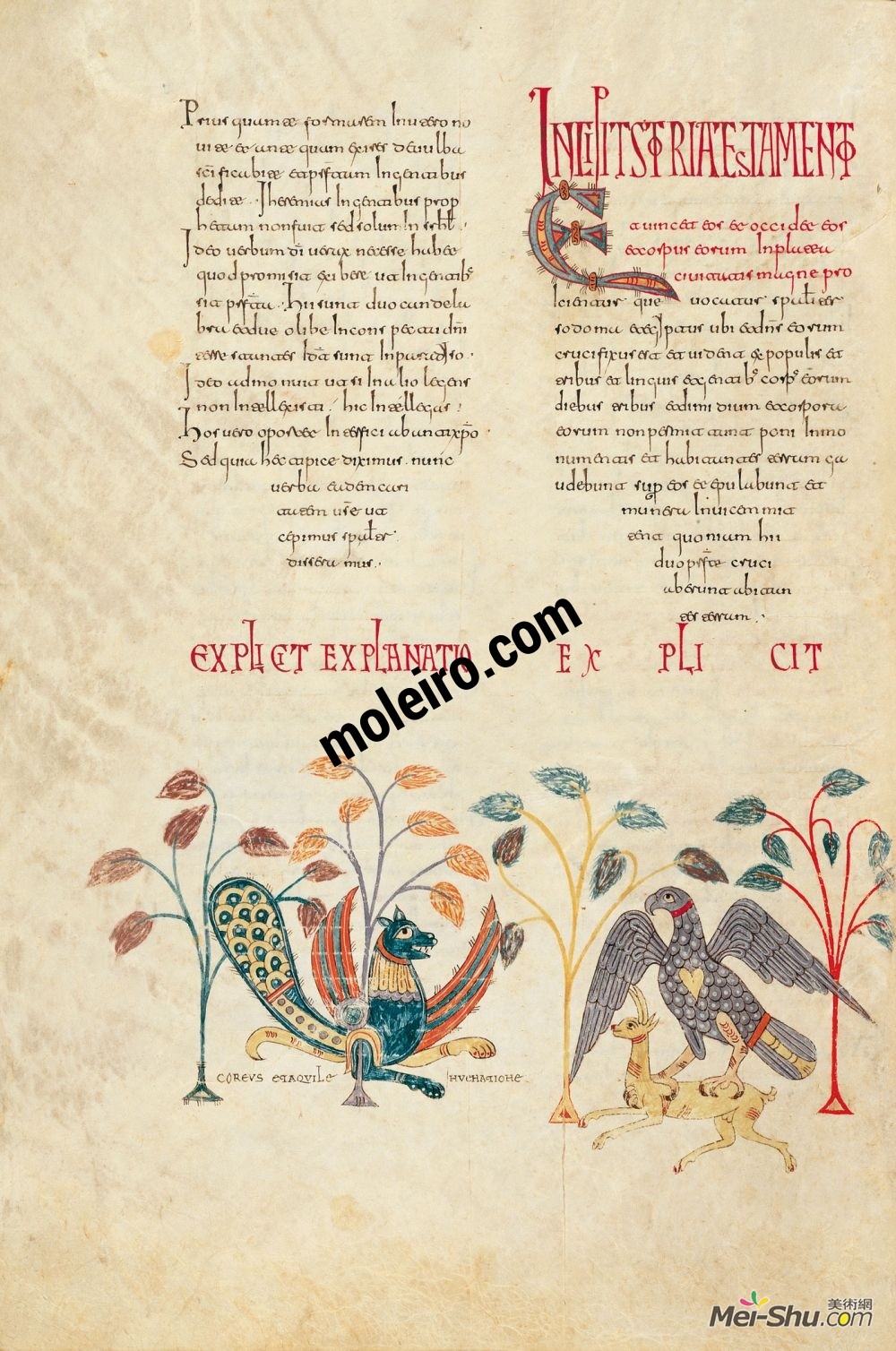 恩德(Ende)高清作品《Decorative miniature. Coreus and the eagle catching the gaze》
恩德(Ende)高清作品《Decorative miniature. Coreus and the eagle catching the gaze》
作品名:Decorative miniature. Coreus and the eagle catching the gaze
艺术家:恩德
年代:c.975
风格:莫札拉布
类型:微型
在左边四棵高画意和装饰性的树木之间有一只动物形的怪物,狮子的身体、鹰的翅膀和孔雀的尾巴,下面有传说“COREVS ET AQVILE/IN VENATIONE”。这只野兽的旁边是一只展开翅膀的鹰,脖子上围着一圈红环,尾巴底部,胸膛上有一颗心形,爪子里抓着一只瞪羚。这两种动物的来源在于通过伊斯兰教艺术传播的波斯艺术。表现两只动物之间神话斗争的伊朗神话这一主题的原初含义,在《吉罗娜·比图斯》中迷失了,这部小说把主题描绘成一种虚构的狩猎场景,尽管如此,它并没有失去东方的惊奇感。第一个怪物是一种古老的东方生物,被称为森穆尔夫或西姆尔格,出现在萨珊的岩石浮雕上,用金属、象牙制品和伊斯兰和拜占庭织物制成。抓住羚羊的鹰也出现在安达卢西亚浮雕和狮鹫身上。在威尼斯前圣伊拉里奥修道院9世纪地板上的马赛克上,可以看到鹰-科鲁斯的组合,这种组合经常出现在来自意大利南部的10世纪手稿的装饰中。这种类型的狩猎动物在大理石和象牙中的伊斯兰教物品中很常见。在安达卢西亚的Omia工场,丝绸织品为这种大理石制品提供了模型。此外,虽然有时很难区分安达卢西亚和拜占庭的物品,但从10世纪以来就有证据表明拜占庭织物在列昂销售。没有什么能够表明这些主题出现在属于Gerona Beatus的同一时期的穆斯林手稿中。然而,这个例子确实表明,大多数伊斯兰借贷显然是在末日周期之外的边缘地区发现的。Gerona Beatus以适应伊斯兰环境的最广泛的主题为特色,特别是由于它的大尺寸和大量的羊皮纸。尽管Gerona是Beatus系列中唯一一个以它为特色的,但是Coreus或simurg在其东部形式的表示在西北部西班牙王国中确实很早就出现了,如920年《圣经》中的挂毯页所示(Len,Colegiata de San Isidoro,Cod.6,f.3v),它也在中世纪晚期的西班牙艺术中占有重要地位,采用了更接近拜占庭和萨珊模型的公式。
Title:Decorative miniature. Coreus and the eagle catching the gaze
artist:Ende
Date:c.975
Style:Mozarabic
Genre:miniature
Situated on the left between four highly schematic and decorative trees is a zoomorphic monster with a lion’s body, an eagle wings and a peacock’s tail, with the legend “COREVS ET AQVILE/IN VENATIONE” underneath. Next to this beast is an eagle with outspread wings, a red ring around its neck and the base of its tail and a heart shape upon its chest, seizing a gazelle in its claws. The source of these two animals lies in Persian art transmitted via Islamic art. The original meaning of this theme of Iranian mythology, representing the mythical battle between the two animals, has been lost in the Gerona Beatus which depicts the theme as a sort of imaginary hunting scene which has not, nevertheless, lost the sense of oriental wonder. The first monster is an ancient, eastern creature known as the senmurv or simurgh, appearing in Sassanian rock reliefs, in items worked in metal, ivory items and Islamic and Byzantine fabrics. The eagle seizing the gazelle also appears in Andalusian reliefs along with griffons. The eagle-Coreus combination can be seen in a mosaic in the ninth-century flooring of the former Sant’Ilario abbey in Venice, and often appeared in the decoration of tenth-century manuscripts from southern Italy. Hunting animals of this type are very common in Islamic items worked in marble and ivory. Silk fabrics served as models for such marble articles in the Omeya workshops of Andalusia. Furthermore, there is evidence of the sale of Byzantine fabrics in León since the 10th century – although it is sometimes difficult to differentiate Andalusian from Byzantine items. There is nothing to show that these topics appeared in Muslim manuscripts belonging to the same period as the Gerona Beatus. This illustration does however demonstrate that most Islamic borrowings are obviously to be found outside the Apocalyptic cycle, in marginal areas. The Gerona Beatus features the widest range of subjects adapted from Islamic contexts due, inter alia, to its large size and the large amount of parchment available. Despite Gerona being the only one in the Beatus series to feature it, the representation of Coreus, or simurg in its eastern form, did appear early on in north-western, Hispanic kingdoms, as can be seen in the tapestry page in the Bible of 920 (León, Colegiata de San Isidoro, Cod. 6, f. 3v), and it also featured in the Hispanic art of the late Middle Ages, which employed formulae closer to Byzantine and Sassanian models.
作品名称:恩德(Ende)高清作品:Decorative miniature. Coreus and the eagle catching the gaze
作品链接:https://www.mei-shu.com/famous/27440/artistic-175658.html
作品类别:油画
免责声明:本站部分公开资料来源于互联网,目的是用于学术交流与讨论,并不代表本网赞同其观点和对其真实性负责。如果您认为我们的侵犯了您的权益,请与我们联系(banquan#mei-shu.com #替换为@),我们将在第一时间删除相关内容。